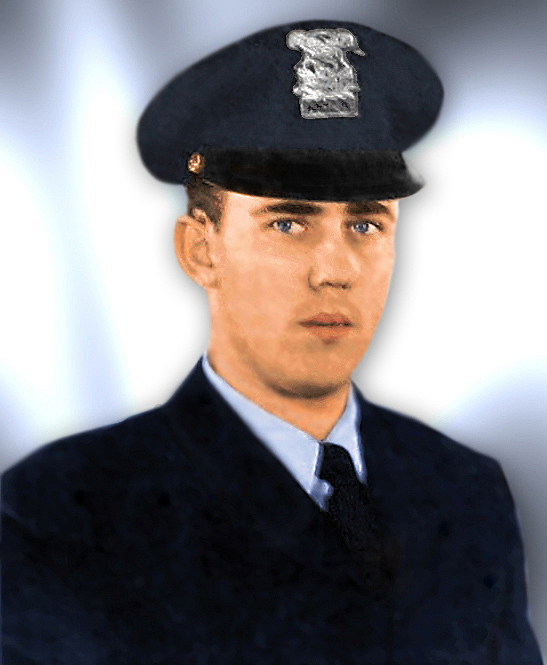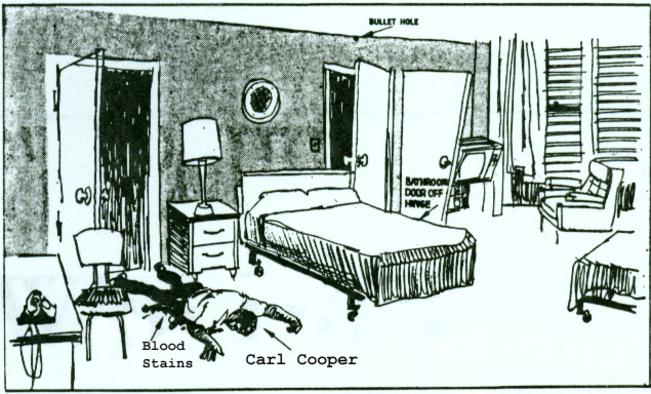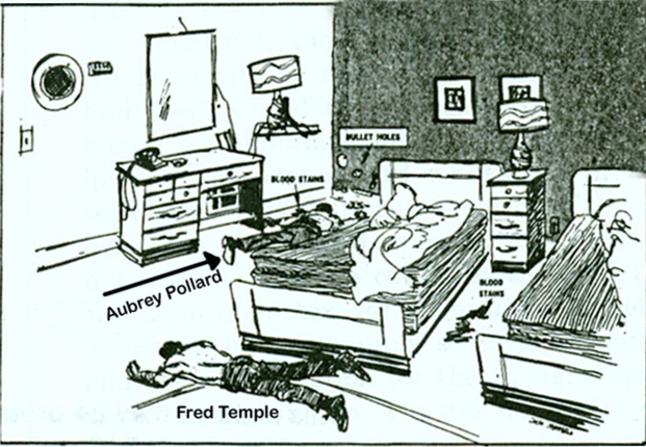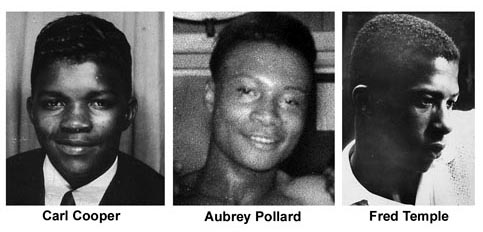Detroit police officer Jerome Olshove, the only Detroit police officer to die during the riot, was shot to death by a looter only hours before the Algiers incident. Olshove was well respected throughout the department. His father was career DPD, as was his brother. After seven years on the job, he had planned on leaving the department and pursue a career at IBM. His last day was to be Thursday. He was killed on Tuesday. His death was announced at roll call. The room was full of ominous groans and open weeping. As was the case during the Newark riot only days before when Newark police detective Frederick Toto was shot to death by a sniper, the death of a comrade may have put Detroit police over the edge.
Seconds before the authorities stormed the house there were clues inside that something was terribly amiss. Looking out the window, a state police car could be seen cautiously approaching up the alley from Euclid. Officers now appeared outside, guns drawn. Upon seeing occupants at the windows, police began firing warning shots. Panic ensued. Carl Cooper, hopelessly trapped on the main floor in a no-mans-land between the front door and the rear, was the first person the authorities encountered as the back doors on the northeast part of the annex were kicked in. Crucial decisions were made in the milliseconds which followed. Was Cooper a sniper? Did he have a weapon or look like he was reaching for one? We will never know. Multiple shot guns blasts killed him instantly.
A deadly similar situation was occurring simultaneously in the back of the residence. As yet another contingent of officers stormed through the back door at the NW corner of the house looking for a sniper, they encountered Fred Temple. Whether Temple was sleeping, watching TV, etc, never came to light. He too was shot during the initial rush into the house.
The authorities then began a floor to floor, room to room, search for snipers and guns. While several guests at the annex admitted later that the starters pistol that Cooper had fired did exist, it was never found. The remaining civilians, ten in all, were ferreted out of their rooms and brought downstairs to spread eagle in the main hallway. An aggressive interrogation began about the reported sniper shots with the lifeless body of Carl Cooper only feet away in the next room. When no answers were forthcoming, a pistol whipping of the suspects began. Still no answers. With the atmosphere growing thick with anger, police began to turn the interrogation screws harder.
Anarchy at the
Anarchy at the Algiers Motel - Detroit
Of all the grim episodes that occurred during the riot, one incident would remain infamous above the rest. During the early hours of Wednesday morning, three black teenagers were shot to death in the annex of the Algiers Motel off Woodward and their deaths remain shrouded in mystery to this day. The incident has lived on primarily because of the inability to piece together the terribly scrambled accounts of both police and civilians alike and the fact that no one was ever convicted. After 50 years, the waters of truth are as murky as ever.
Here is what is known:
* Just after midnight on Tuesday, someone at the motel annex was shooting off a starter’s pistol loaded with blanks simply for amusement.
* A National Guard unit nearby believed it was a sniper and radioed Detroit police.
* Detroit police arrived immediately and in tandem with state troopers and the Guardsmen, stormed the motel annex in search of a sniper.
* By the time the sun rose that morning, three black youths staying at the annex were dead of shot gun blasts and the authorities hoped the incident would be lost in the fog of war as the work of an elusive sniper.
The Algiers Motel as seen from Woodward Avenue with the three story annex in the background.
The Algiers Motel, despite its mystical sounding name, was a far cry from the palm trees and tropical fronds that adorned its rustic sign off Woodward. Built in 1952 when Detroit was at its apex, the clientele were initially weary business men in need of a roof before jetting home. As Detroit began to suffer the sting of economic decline, the Algiers slowly drifted into disrepair and with it came an ever shadier clientele.
The Algiers had indeed gained a dubious reputation. By the time of the riot, Detroit police referred to the Algiers as “flypaper for dope dealers, prostitutes and petty hoods.” The now outmoded Algiers had become primarily a home for transients with no place else to go. Located at 8301 Woodward Ave., the Algiers backed up to the Virginia Park subdivision which sported cavernous three story homes from the early 1900s. When the house at 51 Virginia Park, i.e. directly behind the Algiers Motel, went up for sale, the owners of the Algiers bought it and turned it into an annex to the motel.
As the riot continued to rage through Detroit, a number of individuals, desperate to get off the street and thus out of harms way, took up residence in the annex of the Algiers. All total there were nine people, seven black males and two white females. As the clock ticked midnight on July 25th, 17-year old Carl Cooper was out on the back porch of the annex with a friend firing a starters pistol loaded with blanks into the air, a foolish thing to do at the height of a riot but boys will be boys and subsequently they thought nothing of it.
Unbeknown to the boys, their merrymaking had caught the attention of the National Guardsmen who had secured a large building 200 ft away. Upon hearing the shots, the Guardsmen believed they were the target of a sniper from the direction of Virginia Park. The Guardsmen commander, Warrant Officer Theodore Thomas, telephoned the Detroit police dispatcher who may have over emphasized the situation, "Army under heavy fire at Woodward and Euclid," echoed through Detroit police cruisers. Thomas was amazed to see Detroit police show up immediately, with additional Guardsmen and state police in tow.
The rear of the annex where the homicides took place. Carl Cooper was firing the starter pistol off the porch on the left (Yellow circle). Whether he was intentionally firing in the direction of the Guardsmen or it was just a coincidence will never be known. Fred Temple was killed in the room on the right (red circle).
Note the multiple ground floor entrances on either side of the house.
A combination of Detroit police, Guardsmen and state police rushed the front and back entrances at approximately the same time with the belief that a sniper or snipers where inside. Exactly who went in first and thus did the initial shootings (Carl Cooper) has remained a mystery to this day.
Frederick Toto
Newark Police
Jerome Olshove
Detroit Police
Combination of Detroit police, State police and Guardsmen rushed the three entrances to the manor house at approximately the same time believing a sniper was inside.
N
One of the suspects, Roderick Davis, was pulled off the line and brought into room 4A, directly behind the line up. The door closed behind them. The officer instructed Davis to spread eagle on the floor, remain quiet and then shot into the floor. Back out in the hallway the remaining suspects believed Davis had been shot. It was actually a death game, an attempt to extract a confession regarding who the "sniper" was by instilling fear. Unfortunately either no one still in the line-up had any knowledge of Carl Cooper firing off the starter pistol earlier or were too scared to mention it, thus no confessions were forthcoming and so the game continued.
Another suspect, Michael Clark, was brought into another room, spread eagle on the floor and another errant shot fired, this time into the ceiling. Still no confessions. Now it would be Aubrey Pollard's turn. Pollard was brought back into room 3A where the dead or dying Fred Temple still lay. The possibility exists that this officer may himself have been unaware that this was only a game to extract a confession. Pollard was shot shortly after he entered the room. According to the officer, the terrified Pollard reached for his shot gun twice believing he was going to be shot, presumably like the others, and only then did the officer fire. As for Pollard, dead men tell no tales.
It was now apparent that the death game that had started simply as a scare tactic to extract confessions regarding an elusive sniper had now gotten completely out of hand. The Guardsmen, following the lead of the state police who had left earlier after sensing the gravity of the situation, also high stepped it out of the building, telling the police that this was "strictly their business." They were followed in short order by the remaining Detroit police who left to address reports of more shootings nearby, leaving the terrified survivors behind.
The police, it appeared, had initially hoped the killings would be lost in the fog of war or be viewed as the work of a rogue and elusive sniper. But the witnesses and evidence they left behind indicated otherwise. All the autopsies indicated the youths were killed inside the house at close range by a shotgun using double “O” buckshot, the same kind used by the Detroit police department for riot control.
Apt 2A - Carl Cooper was the first to die. Only minutes after firing off the starter pistol for amusement, Cooper seems to have realized that his merrymaking had caught the attention of the authorities who were now advancing on the house, guns drawn. Panic time.
As the police barreled through the N.E. door, they immediately came across Cooper who was shot in the stomach, dying shortly there after.
Since investigators were never able to determine who exactly went through the back doors first, no one was ever charged with the shooting.
Although accounts differ, most agree that Fred Temple, like Cooper, was killed upon the initial inrush into the house.
Aubrey Pollard was the last to die, killed during the "game of death" which coincided with the police interrogations.
Detroit police return to the Algiers annex the following morning to begin an investigation into the incident,
unbeknown to them that their
own people were heavily involved.
Algiers victims: Carl Cooper, 17, Aubrey Pollard, 19, Fred Temple, 18 years old.
The irony of ironies, three young lives cut short because of horse play with a starter pistol that attracted the police who crashed through the door looking for a sniper that didn't exist.
A week after the riot it was clear that Detroit police were complicit in the killings. Three officers and a private guard were arraigned on a variety of charges. Owing to the publicity generated by the best selling book by John Hersey, “The Algiers Motel Incident,” published in 1968, the defense asked for the trials to be moved out of Detroit. Their petitions were granted. Trials were held in Lansing, Ann Arbor and Mason. In the end all were acquitted and the rage in black Detroit ratcheted up even further.
It must be remembered who the state senator representing Detroit was at this time. Coleman A. Young,
D-Detroit, was outraged, “This latest phase of a step by step whitewash of police slayings demonstrates once again that law and order is a one-way street; there is no law and order when black people are involved. Especially when they’re involved with the police.” Young’s stance would play an important role 18 years later when, as mayor, he fired two white police officers for their roles in beating a black motorist who eventually died. His quick response in accusing and firing the officers were in part dictated by the ghastly memories of the Algiers Motel incident.
End of the Algiers - Only a handful of bricks remain from the oft vilified Algiers Motel. Both the Algiers Motel and its annex were torn down in the 1970s, successfully ridding the city of its most haunting icon of the riot. The psychological scars of the community, however, have never healed.










